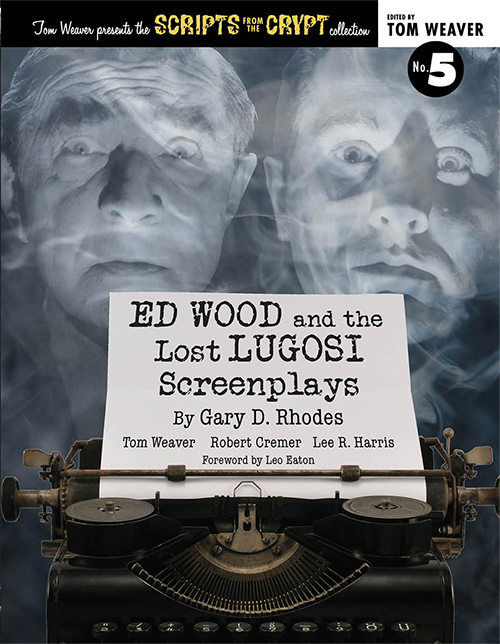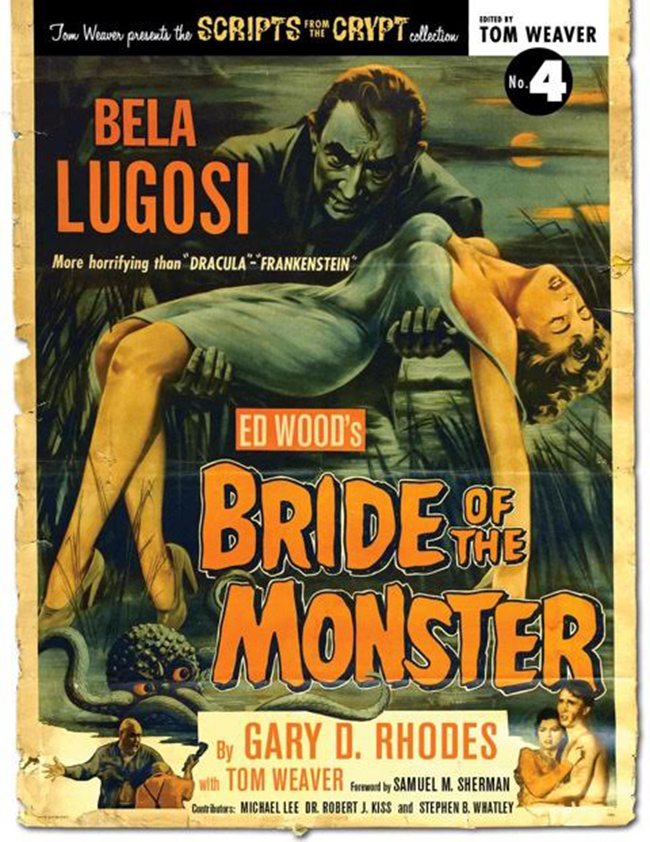|
|||||||||||||||||
November 2009 Web Edition Issue #3 |
|||||||||||||||||
| Mondo Cult Forum Blog News Mondo Girl Letters Photo Galleries Archives Back Issues Books Contact Us Features Film Index Interviews Legal Links Music Staff |
Gary Rhodes2 Biggest Hitsby Michael Copner
Liz Renay used to claim that good things come in pairs. And in her magnificent body of work they truly did! In this Mondo Cult assignment there will be a lot of twos. Buddy Barnett and me: we’ll each write reviews about the two books to reach the market written by Gary Rhodes. They may as well be “book end” books about the final two films released while Bela Lugosi was alive, as these books are devoted to the works of Ed Wood and Bela Lugosi—two truly unique filmmakers in the horror field. To continue the pattern of twos, I’d almost like to call this article “If Bedrooms Could Talk” or some such thing. For Cult Movies magazine was birthed in the front bedroom of an apartment I lived in for 15 years. The first two issues were collated and stapled by work parties in that room. As Cult took off, a variety of celebrities stayed in that room, from porn directors to musicians, horror actors, film writers and more. Tongolele stayed for 2 days, Coffin Joe for 2 weeks, while Korla Pandit lived there for 2 years. Two of my favorite Cult writers to stay, about 2 years apart, were young Guy Tucker and Gary D. Rhodes—each about 20 when they came out to Hollywood for a visit. Each stayed, as I recall, for roughly 2 weeks. Guy was a true marvel. He loved Japanese cinema so much that he taught himself to read, write and speak in the Japanese language by the time he was 15 years old, since he had every intention of contacting the film magicians who made those amazing giant monster epics at Toho, Daia and other studios. He did indeed travel to Japan, where the movie people were astounded that a teenage American kid would be so enamored of their films, country and culture. When Guy arrived in Tokyo he was welcomed by everyone behind the scenes of those films and TV shows. His book, based on several years of research and in-person interviews, was called Age of the Gods. It was truly a masterpiece for one of any age to have written. But only 1,000 copies were printed. At that time, Cult Movies was printing 15,000 copies of each issue. Guy felt he’d reach a wider audience if he wrote new articles based on his book. The short essays were a joy to read. As our mutual friend Dave Milner stated, “Guy sees things in films many people don’t see. His critiques are very deep.” Guy wanted to see any film down in LA’s Little Tokyo, so we did that. He also had a list of a few art museums—so we visited—and he really liked the Hollywood Walk of Fame. I was surprised that as a brazen kid who’d introduced himself to his Japanese film idols, he was shy about going up to meet Forry Ackerman, 2 weeks in a row, passing up the chance to tour the fabulous Ackermansion on open house Saturdays. For several years after, during our phone calls he’d say, “I’m still kicking myself for not going up there and meeting Mr. Ackerman.” Guy and I stayed friendly on the phone for 10 years. We talked on the phone at 2 or 3 in the morning, PST, when he’d call me from his room at his mother’s New York home (where he’d usually been watching videos all night). I’m sure he had more books to write, but he only did the one masterpiece. It was sad news to receive, in 2007, that the young man had suffered a fatal heart attack lying in bed, imbibing in a beer, a cigarette and a Godzilla DVD. I’ll always remember you my friend. In distinction to Guy is our other young film student—now film professor—Dr. Gary D. Rhodes. When Gary first came to Hollywood from his home in Ardmore, OK, he had a meeting firmly in place with Forry Ackerman. I drove us the few blocks up the hill from my apartment to the Ackermansion, where Gary spent hours poring over the artifacts which fascinated him the most. It wasn’t all Lugosi, I’d noticed, but certainly a big part of his interest was focused there. I believe Gary was around 15 years old when he began publishing a Bela Lugosi fan magazine. His productivity spiraled upward from there. Lugosi’s life-work inspired Gary’s love of film. He took college film courses, wrote 10 books and made an excellent documentary about a recent attempt at film censorship in his home state of Oklahoma. To date. He is currently Postgraduate Director for Film Studies at Queen’s University of Belfast, Northern Ireland. Several times I’ve told Gary I believe it’s a shame he never knew or spoke with Guy Tucker. They had much in common, and I feel they would have become good friends.  Gary D. Rhodes at Whitby Abbey, North Yorkshire, England (PHOTO | Kristin Dewey)
Gary D. Rhodes at Whitby Abbey, North Yorkshire, England (PHOTO | Kristin Dewey)In 2015, one of Gary’s best books was published, this one via Bear Manor Media, entitled Ed Wood’s Bride of the Monster. The book reveals many things about what one critic called “A film by Wood that actually looks like a real film!” Ever the digger and researcher, Gary Rhodes now presents a 287 page collection of rare stills, the pressbook, original shooting script, a special chapter by Dick Sheffield (young friend of Bela’s) and a foreword by Sam Sherman. There’s a lot of material originally published in Cult Movies. There’s also something included which made me feel closer to Ed Wood thatn I’ve ever felt. David Wentink provided a personal interview—a whopping 5 pages!—which film director Fred Olen Ray conducted via written pages he sent from Orlando, FL. Fred typed out some questions and Eddie scribbled answers to all of them in 1978—the year Ed died. Eddie states he sold his first short story (The Sunset Murders) to Street and Smith Publishers when he was 12 years old. He went on to sell many, many stories and 131 novels. Seeing these reproduced pages of credits, Bela info and production details brought Wood back to life as much as any movie by Tim Burton. Worth the cover price alone. (By the way, it’s only $24.95.) Also personal and heartwarming is Gary’s most recent book, Ed Wood and the Lost Lugosi Screenplays, also from Bear Manor Media and a bargain at 301 pages. Some people felt in the past that Wood used Lugosi to work his way into legit films. I feel the reverse, that there was an admiration between the 2—another gruesome two-some?—and that they helped each other in ways ranging from film work to mutual emotional support and esteem. Ed had 3 scripts completed with Lugosi in mind. The films got shelved in their intended versions for the most fateful of reasons: Bela’s death. Looking through the scripts gives the reader a sense of what the movies might have been. Indeed. The entire book is a 60-year-old preview of what might have been. Again, that’s worth the price of the book. Lee Harris adds depth, insight and contagious enthusiasm about the evolution of Ed’s films in his specially commissioned chapter highlighting The Final Curtain. I was involved in the adult entertainment business in the 1980s and edited Cult Movies for its 1990s duration. So, in many ways for me, the enthralling chapter in the book is the one by Leo Eaton, describing his working relation with Bernie Bloom, owner of Pendulum Publishing, a company issuing many men’s magazines, both hard-core and soft-core sex titles. The company employed 4 writers in their offices, one of whom was Ed Wood. Many details are mentioned by Leo, such as the one that on certain days, Ed would come to work dressed as a man, while on others he’d arrive for work in a wig and mini-skirt in his alter ego as Shirley. And it was production line writing. All 4 writers punched a time clock, wrote for 8 hour days, first draft copy—and it had better be sexy! No question, these 2 books on Wood and Lugosi are cool reading for left of center film fans who enjoy these somewhat underground motion pictures.  | ||||||||||||||||




